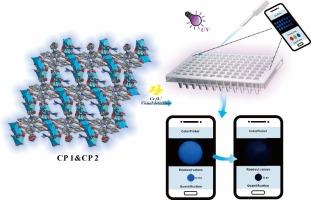基于新型多功能镉(II)发光配位聚合物的高效智能手机发光传感检测技术
IF 4.6
2区 化学
Q1 SPECTROSCOPY
Spectrochimica Acta Part A: Molecular and Biomolecular Spectroscopy
Pub Date : 2024-10-05
DOI:10.1016/j.saa.2024.125248
引用次数: 0
摘要
基于混合配体策略,两种新的等结构 CdII 配位聚合物:{CP 1)和{[Cd3(tcpa)2(bmima)(DMF)]‧3DMF}(CP 2)的合成是通过溶热法将两种柔性蒽基配体和一种富含大π电子结构的三苯胺基配体(H3tcpa = 三(4-羧基苯基)胺,bima = 9,10-双(1H-咪唑-1-基)甲基)结合在一起实现的;bima = 9,10-双(1H-咪唑-1-基)甲基)蒽和 bmima = 9,10-双((2-甲基-1H-咪唑-1-基)甲基)蒽)。氯化石蜡 1 和氯化石蜡 2 显示出一种新的三维 (3,14)-c 网状结构,其拓扑结构为 {430-648-813}{43}4 。这两种氯化石蜡都能通过快速荧光淬灭反应检测 Cr2O72-、硝基芳香族炸药 2,4,6-三硝基苯酚(TNP)和 2,4-二硝基苯酚(DNP),淬灭效率 Ksv 高,LOD 低,仅为 0.CP 1 为 19 μM(Cr2O72-)、0.54 μM(TNP)、0.76 μM(DNP),CP 2 为 0.28 μM(Cr2O72-)、0.23 μM(TNP)、0.65 μM(DNP)。此外,通过实验研究和理论模拟,提出了 CPs 对 Cr2O72-、TNP 和 DNP 的淬灭机理。CPs 对 Cr2O72- 的淬灭主要是通过竞争吸收(CA)实现的,而对 TNP/DNP 的淬灭则是通过竞争吸收 CA、光诱导电子转移(PET)和荧光共振能量转移(FRET)共存实现的。此外,我们还开发了一种便携式智能手机辅助现场检测平台,可根据荧光颜色的变化对 Cr2O72- 进行半定量分析。这项工作构建了一个比率测量传感平台,可快速、便捷地检测 Cr2O72-、TNP 和 DNP 污染物。本文章由计算机程序翻译,如有差异,请以英文原文为准。

Efficient smart-phone luminescent sensing detection based on new multifunctional Cd(II) luminescent coordination polymers
Based on the mixed ligand strategy, two new isostructural CdII coordination polymers: {[Cd3(tcpa)2(bima)(DMF)]‧3DMF} (CP 1), {[Cd3(tcpa)2(bmima)(DMF)]‧3DMF} (CP 2) were synthesized by combining two flexible anthracene-based and a triphenylamine-based ligands with large π-electron-rich structure using a solvothermal method (H3tcpa = tris(4-carboxyphenyl)amine; bima = 9,10-bis(1H-imidazole-1-yl)methyl)anthracene and bmima = 9,10-bis((2-methyl-1H-imidazol-1-yl)methyl)anthracene). CP 1 and CP 2 show an unreported new 3D (3,14)-c net structure with the {430·648·813}{43}4 topology. Both CPs could detect Cr2O72−, Nitroaromatic explosives 2,4,6-Trinitrophenol (TNP) and 2,4-dinitrophenol (DNP) through rapid fluorescence quenching response with high quenching efficiency Ksv and low LOD with 0.19 μM (Cr2O72−), 0.54 μM (TNP), 0.76 μM (DNP) for CP 1 and 0.28 μM (Cr2O72−), 0.23 μM (TNP), 0.65 μM (DNP) for CP 2, respectively. In addition, the mechanism of quenching Cr2O72−, TNP and DNP by CPs is proposed through experimental research and theoretical simulation. The quenching of Cr2O72− by CPs is mainly competitive absorption (CA), while the quenching of TNP/DNP is achieved through the coexistence of competitive absorption CA, photo induced electron transfer (PET) and fluorescence resonance energy transfer (FRET). Moreover, we have been developed a portable smartphone-assisted on-site detection platform, which can perform semi-quantitative analysis of Cr2O72− acconding to fluorescence color changes. This work constructed a ratiometric sensing platform for quickly and conveniently detection of Cr2O72−, TNP and DNP pollutants.
求助全文
通过发布文献求助,成功后即可免费获取论文全文。
去求助
来源期刊
CiteScore
8.40
自引率
11.40%
发文量
1364
审稿时长
40 days
期刊介绍:
Spectrochimica Acta, Part A: Molecular and Biomolecular Spectroscopy (SAA) is an interdisciplinary journal which spans from basic to applied aspects of optical spectroscopy in chemistry, medicine, biology, and materials science.
The journal publishes original scientific papers that feature high-quality spectroscopic data and analysis. From the broad range of optical spectroscopies, the emphasis is on electronic, vibrational or rotational spectra of molecules, rather than on spectroscopy based on magnetic moments.
Criteria for publication in SAA are novelty, uniqueness, and outstanding quality. Routine applications of spectroscopic techniques and computational methods are not appropriate.
Topics of particular interest of Spectrochimica Acta Part A include, but are not limited to:
Spectroscopy and dynamics of bioanalytical, biomedical, environmental, and atmospheric sciences,
Novel experimental techniques or instrumentation for molecular spectroscopy,
Novel theoretical and computational methods,
Novel applications in photochemistry and photobiology,
Novel interpretational approaches as well as advances in data analysis based on electronic or vibrational spectroscopy.

 求助内容:
求助内容: 应助结果提醒方式:
应助结果提醒方式:


